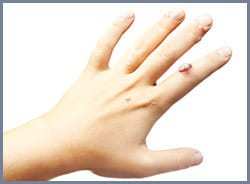Warts Treatment
This article describes the three types of warts, their signs and symptoms, causes, and if you get them (anyone can), strategies for warts treatment.
Warts are benign (not cancerous) skin growths that appear when a virus infects the top layer of the skin. Viruses that cause warts are called human papillomavirus (HPV). You are more likely to get one of these viruses if you cut or damage your skin in some way.
Wart viruses are contagious. Warts can spread by contact with the wart or something that touched the wart. Warts can grow on any part of your body.
Warts are often skin-colored and feel rough, but they can be dark (brown or gray-black), flat and smooth.
There are a few different types of warts. The type is determined by where it grows on the body and what it looks like. The following describes the signs (what a person sees) and symptoms (what a person feels) for some of the different types of warts.

Common Warts
Common Warts
Also called vurruca vulgaris
If you see a wart on your child’s face, check your child’s hand for warts. The virus that causes warts can spread from the hand to the face through touch or nail biting.
Common warts have these traits:
— Grow most often on the fingers, around the nails, and on the backs of the hands.
— Are more common where skin was broken, such as from biting fingernails or picking at hangnails.
— Can have black dots that look like seeds (often called “seed” warts).
— Most often feel like rough bumps.Foot warts
Also called plantar warts
Plantar warts have these traits:
— Grown most often on the soles (plantar surface) of the feet.
— Can grow in clusters (mosaic warts).
— Often are flat or grow inward (walking creates pressure, which causes the warts to grow inward).
— Can hurt, feels like you have pebbles in your shoe.
— Can have black dotsFlat warts
This type of wart has these traits:
— Can occur anywhere. Children usually get them on the face. Men get these most often in the beard area, and women tend to get them on their legs
— Are smaller and smoother than other warts.
— Tend to grow in large numbers – 20 to 100 at a timeFiliform Warts
A filiform wart has these traits:
— Looks like long threads or thin fingers that stick out
— Often grows on the face: around the mouth, eyes, and nose
— Often grow quicklyHIV weakens the immune system, so the body often cannot fight the virus that causes warts.
Anyone can get warts. Some people are more prone to getting a wart virus (HPV) than others. These people are:
— Children and teens
— People who bite their nails or pick at hangnails
— People with a weakened immune system (the body’s defense system)In children, warts often go away without treatment. A dermatologist should treat warts that hurt, bother the child, or quickly multiply
Viruses called human papillomavirus (HPV) cause warts. It is easier to catch a virus that causes warts when you have a cut or scrape on your skin. This explains why so many children get warts. Warts also are more common on parts of the body that people shave such as the beard area in men and the legs in women. You can spread warts from one place on your body to another.
Warts can spread from person to person. You can get warts from touching a wart on someone’s body. It often takes a few months for warts to grow large enough to see.
Warts can often be treated at home. The following explains when you can safely treat warts at home and when you should see a dermatologist.
Self-Treatment
You can get some wart remedies without a prescription and treat the warts yourself. This may be enough to get rid of the warts. The only problem with self-treatment is that you might mistake another kind of skin growth for a wart. Some skin cancers look like warts.
You should see a dermatologist when you have:
— A suspicion that the growth is not a wart
— A wart on your face or genitals
— Many warts
— Warts that hurt, itch, burn or bleed
— A weakened immune system
— Diabetes. Never try to remove any wart on your foot if you have diabetes. If you cut or burn your skin, it could cause lasting damage to the nerves in your feet.At-Home Remedies
You can use the following at home:
Salicylic Acid: You can treat warts at home by applying salicylic acid. This medicine is available without prescription. It comes in different forms – a gel, liquid or plaster (pad). You should apply salicylic acid to the wart every day. Before applying the salicylic acid, be sure to soak the wart in warm water. Salicylic acid is rarely painful. If the wart or the skin around the wart starts to feel sore, you should stop treatment for a short time. It can take many weeks of treatment to have good results – even when you do not stop treatment.
Other Home Remedies: Some home remedies are harmless, such as covering warts with duct tape. Changing the tape every few days might peel away layers of the wart. Studies conflict, though, on whether duct tape really gets rid of warts. Many people think certain folk remedies and hypnosis get rid of warts. Since warts may go away without treatment, it’s hard to know whether a folk remedy worked or the warts just went away.Ask your dermatologist if you are unsure about the best way to treat a wart.
Prevention
To prevent warts from spreading, dermatologists recommend the following:
— Do not pick or scratch at warts.
— Wear flip-flops or pool shoes in public showers, locker rooms, and pool area.Do not touch someone’s wart
— Keep foot warts dry, as moisture tends to allow warts to spread.




